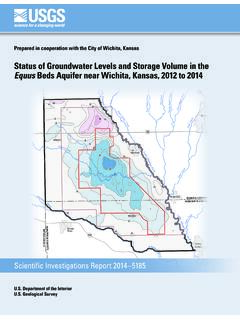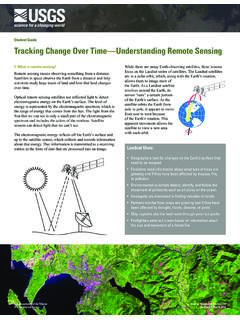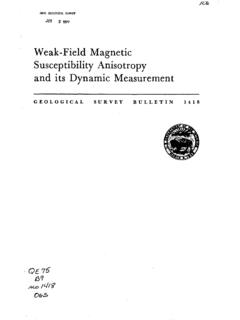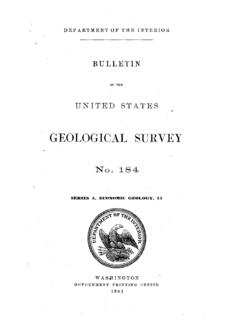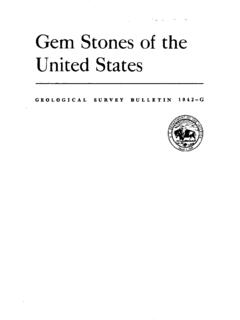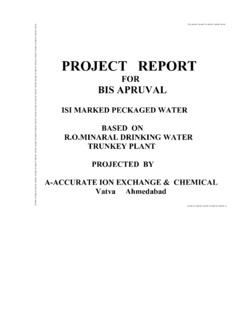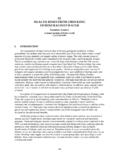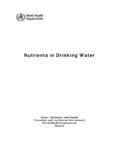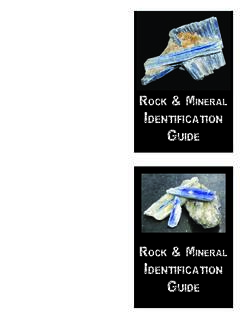Transcription of GEOPHYSICAL METHODS IN EXPLORATION AND MINERAL ...
1 19 GEOPHYSICAL METHODS IN EXPLORATIONAND MINERAL ENVIRONMENTAL INVESTIGATIONSby Donald B. Hoover, Douglas P. Klein, and David C. CampbellINTRODUCTIONIn the following discussion, the applicability of GEOPHYSICAL METHODS to geoenvironmental studies of ore deposits isreviewed. Details of GEOPHYSICAL techniques are not emphasized; these are covered in standard texts (Society ofExploration Geophysicists, 1966; 1990) and have been summarized in Hoover and others (1992).Various GEOPHYSICAL METHODS are identified in table 1 (adapted from a chart compiled by Companie Generalde Geophysique, Massy, France and published with modification by Van Blaricom, 1980). The table identifies theutility of each method in airborne, ground, or borehole applications.
2 Borehole METHODS are a specialized branch ofgeophysics that are not emphasized here. However, where ground disturbance is not prohibited, or where drillholesexist, there are a variety of useful borehole, crosshole, and borehole-surface techniques that may aid geoenvironmental studies (Mwenifumbo, 1993).Table 1 also outlines physical parameters and properties, anomaly sources, and depth of investigation foreach method. If a feature of geoenvironmental concern does not have an associated, measurable, physical propertythen GEOPHYSICAL investigations are not applicable. Depth of burial (of contaminant plumes, for instance) is extremelyimportant in assessing the potential applicability of geophysics in geoenvironmental hazards identification.
3 GEOPHYSICAL responses for more deeply buried sources decrease in amplitude and increase in spatial wavelength untilthey disappear into geologic noise. Physical properties of cover, host rock, and MINERAL waste strongly influenceresponses of potentially hazardous material and are also important for evaluating the utility of a method ingeoenvironmental GEOPHYSICAL METHODS , such as gamma-ray spectrometry and remote sensing, measure surface attributes;others, such as thermal and some electrical METHODS are limited to detecting relatively shallow features but may helpidentify features at greater depth. Secondary effects of deeper features, such as geochemical haloes, can often beidentified by these modeling provides generalized and non-unique solutions to questions concerning the geometryof subsurface geologic relations.
4 The non-uniqueness of these solutions is both a mathematical problem and onerelated to the multiplicity of sources that can cause GEOPHYSICAL anomalies. This feature is an implicit uncertaintyin the discussion that follows. Environmental geophysics, like EXPLORATION geophysics, requires complimentarygeophysical surveys integrated with geochemical and geologic presentation first summarizes GEOPHYSICAL METHODS . Following the METHODS summary, geophysicalstrategies (that usually employ multi-technique approaches) for specific geoenvironmental investigations METHODG ravity measurements define anomalous density within the Earth; in most cases, ground-based gravimeters are usedto precisely measure variations in the gravity field at different points.
5 Gravity anomalies are computed by subtractinga regional field from the measured field, which result in gravitational anomalies that correlate with source bodydensity variations. Positive gravity anomalies are associated with shallow high density bodies, whereas gravity lowsare associated with shallow low density bodies. Thus, deposits of high-density chromite, hematite, and barite yieldgravity highs, whereas deposits of low-density halite, weathered kimberlite, and diatomaceous earth yield gravitylows. The gravity method also enables a prediction of the total anomalous mass (ore tonnage) responsible for ananomaly. Gravity and magnetic (discussed below) METHODS detect only lateral contrasts in density or magnetization,respectively.
6 In contrast, electrical and seismic METHODS can detect vertical, as well as lateral, contrasts of resistivityand velocity or of gravity to MINERAL deposit environmental considerations includes identification of lithologies,structures, and, at times, orebodies themselves (Wright, 1981). Small anomalous bodies, such as undergroundworkings, are not easily detected by gravity surveys unless they are at shallow METHODThe magnetic method exploits small variations in magnetic mineralogy (magnetic iron and iron-titanium oxideminerals, including magnetite, titanomagnetite, titanomaghemite, and titanohematite, and some iron sulfide minerals,including pyrrhotite and greigite) among rocks. Measurements are made using fluxgate, proton-precession,20 Table 1.
7 Summary of GEOPHYSICAL METHODS and their characteristics applicable to EXPLORATION and geoenvironmental studies.[In method column: A, airborne surveys; B, borehole surveys; and G, ground surveys]MethodPhysical parameterTypical unitsRelevant physicalTypical source of Depth of investiga-measuredpropertyanomalytionGra vity: A,B,GTotal attraction ofMilligals or gravity unitDensityRock density con-AllEarth's gravity field( mGal)trasts(the vertical attrac-tion of anomalousmasses)Gradient of Earth'sE tv s unit (10 gal/cm)gravity field-9 Magnetic: A,B,GVector component,Nanotesla, or gammasMagnetic suscep-Magnetic suscep-Surface to Curieor total attraction oftibility and rema-tibility and (or) rema-isothermEarth's magneticnent magnetizationnent magnetizationfield "contrastsGradient of Earth'sNanotesla/m "magnetic fieldGamma-rayRate of gamma-rayCounts/secondQuantity of K+U+K+U+Th contrasts in Upper 50 cmscintillometry: A,B,Gphotons receivedTh and daughtersEarth's upper 50 cmGamma-rayRate of gamma-rayCounts/second in spectralQuantity of K,U,ThK,U, and Th con- "Spectrometry: A,B,Gphotons receivedregions.
8 If calibrated, %Kand daughterstrasts in Earth's upperand their energyand PPM equiv. U and Th50 cmSeismicSeismic energyMeters, millisecondsVelocity of P or SStructures or velocityAllrefraction: B,Gtravel timewaveslayer contrastsSeismic " " " " "reflection: B,GThermal bore-hole or shallowThermal gradient orDegrees C/m, degrees CThermal conductiv-Thermal flux or con-Hole depthhole: Btemperatureityductivity variationsThermal remote sensing: A,GSurface temperatureDegrees CThermal inertiaThermal inertia con-About 5 cmday and nighttrastsElectrical (see text)Direct current resistivity: B,GElectrode positionMeter, amps, millivolts;ResistivityLateral or verticalAbout 2 kmseveral variations in elec-(m), applied currenttypically converted to unitschanges in resistivitytrode geometry(A), and electricof resistivity (Ohm-m)field (mV)Electromagnetic methodsDependent onImpedance (Ohms) orConductivity (in-Lateral or verticalShallow (10 m; VLF;(see text): A,B,Gmethod; ratio ofdimensionless ratio; unitsverse of resistivity)changes in Earth100 m, controlledmany variations availablereceived to appliedof conductivity (Sei-conductivitysource), intermediateelectric and mag-mens/m) or resistivity(1 km; AMT), deepnetic fields(Ohm-m)(10 km.)
9 MT)Mise-a-la-masse: B,GApplied DC or lowMillivoltsResistivityConductive bodyA few hundred metersfrequency AC fieldInduced polarization: B,GResistivity changePercent changeInterface ionicMetallic luster miner-About 2 kmw/ frequency (PFE)polarizationals and pore waterPhase angle be-Milliradianstween transmittedand received sig-Clay and zeolitenal()mineralsNormalized area ofMillisecondspart of receivedvoltage decay curveSelf potential: B,GNatural near-staticMillivoltsEh/pH electronicVertical change inA few hundred meters(direct current)conductor; stream-Eh/pH caused byelectric fielding potential andelectronic conductor;thermal couplingground water flow;coefficientsthermal fluxRemote sensing: AReflected radiationRecorded as optical orSpectral reflectance,Changes in spectralSurface onlyintensity (UV, VIS,digital intensity imageAlbedoreflectance and Albe-IR)do21 Overhauser, and optical absorption magnetometers.
10 In most cases, total-magnetic field data are acquired; vectormeasurements are made in some instances. Magnetic rocks contain various combinations of induced and remanentmagnetization that perturb the Earth's primary field (Reynolds and others, 1990). The magnitudes of both inducedand remanent magnetization depend on the quantity, composition, and size of magnetic- MINERAL anomalies may be related to primary igneous or sedimentary processes that establish the magneticmineralogy, or they may be related to secondary alteration that either introduces or removes magnetic minerals. Inmineral EXPLORATION and its geoenvironmental considerations, the secondary effects in rocks that host ore depositsassociated with hydrothermal systems are important (Hanna, 1969; Criss and Champion, 1984) and magnetic surveysmay outline zones of fossil hydrothermal activity.

